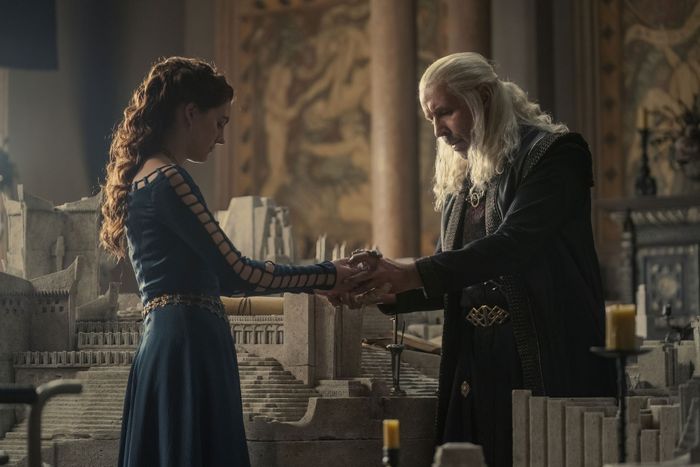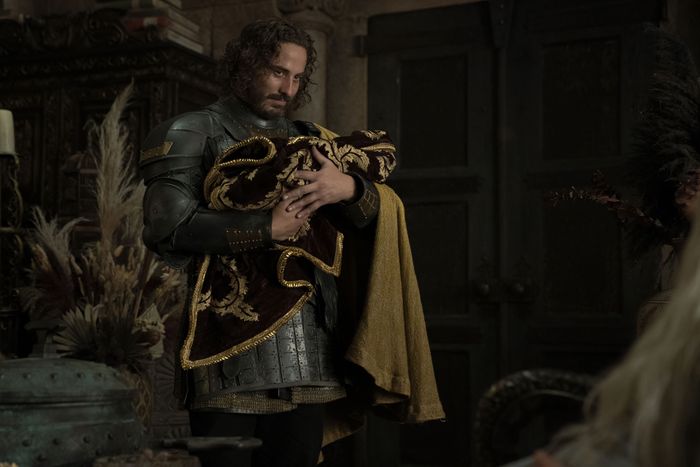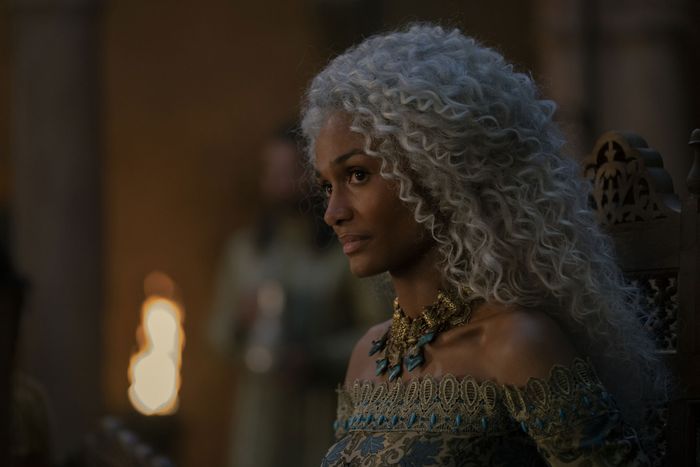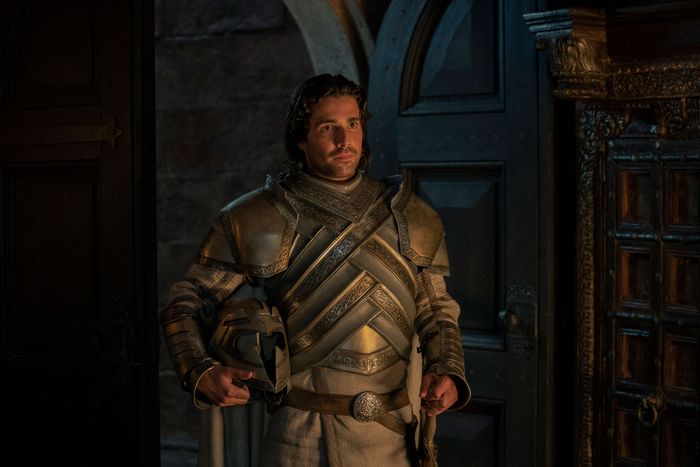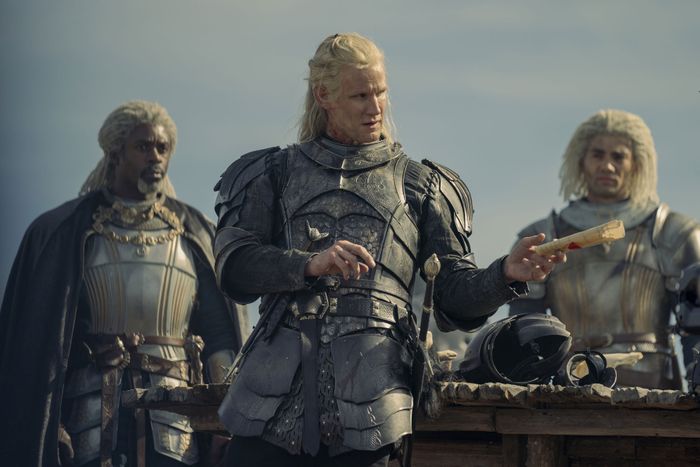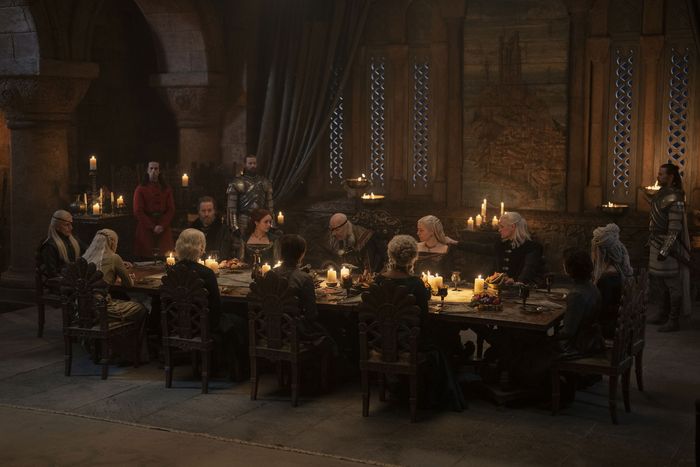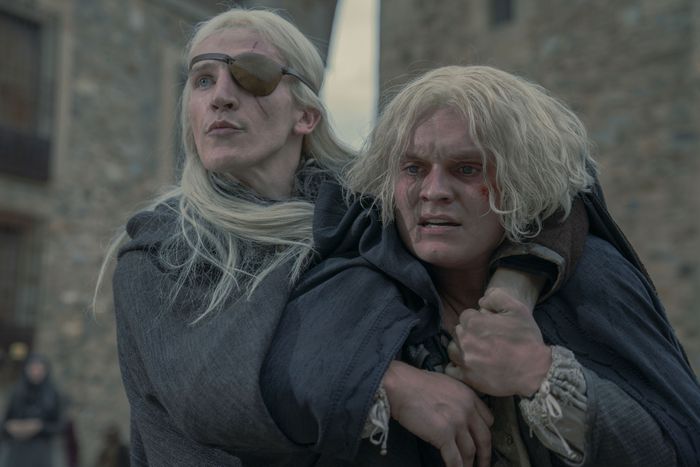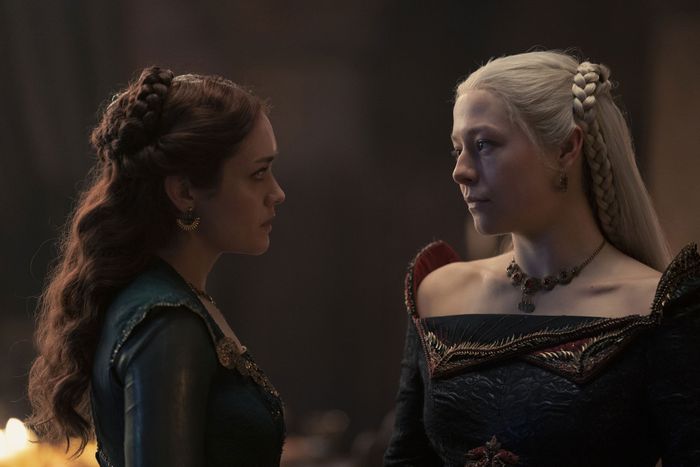
The process of adaptation always means that certain elements of the source material end up on the cutting-room floor. It’s never a one-to-one process, as fans of Game of Thrones should know; lots of characters, subplots, mythology, and lore from the thousands of book pages written by George R.R. Martin didn’t make it into the series. (I won’t spend too much time complaining about how Dorne was done dirty in that series, but book readers, you know it to be true.) House of the Dragon season-one co-showrunners Ryan Condal and Miguel Sapochnik, meanwhile, have the opposite problem: They’re only pulling a few chapters from Martin’s Fire & Blood for the presumed four seasons of their series.
Fire & Blood is an in-universe history book that claims to be compiled from a number of different (fictional) sources: grand maesters who served during this time period, “accounts written decades later by the children and grandchildren of those caught up in the events of these times,” contrasting perspectives from the devout Septon Eustace, who served in the Red Keep and “set down the most detailed history of this period,” and the court fool, Mushroom, whose tawdry, vulgar, and gossipy testimony recounts “ribald tales and gossip, piling stabbings, poisonings, betrayals, seductions, and debaucheries.” The volume is intentionally contradictory and acknowledges that “the question of what to believe and what to doubt remains for each student to decide,” which the House of the Dragon team have described as permission for their own adaptive choices. As Condal told Variety, “We’re expected to take the one true history out of this book? No. The thing that George is laughing at on the side is how anybody can read Fire & Blood and think that this is the one true official account of anything. It’s an expression of this story.”
That’s a tidy justification for one’s adaptation choices, and Condal has defended the series’ approach, saying he, Sapochnik, and the writing team selected what they would adapt from Fire & Blood based on what they perceived as the viewers’ “understanding of the story or where it goes.” What has rankled all season, though, is how often House of the Dragon relied on unexpected time jumps and a rapid narrative pace, discarding characters soon after their introductions and alluding to tensions between spouses, siblings, friends, and colleagues rather than showing them.
Now granted, the Mushroom character in Fire & Blood describes some particularly queasy scenes, like Daemon training a teen Rhaenyra in how to please a man, including oral-sex lessons, and Aegon being found in Flea Bottom with a child sex slave. And Martin hasn’t yet met a female character he doesn’t love to describe in eye-rolling terms: Rhaenyra resents Alicent for losing her baby weight while she grew “stout and thick of waist, the beauty of her girlhood a fading memory,” and 13-year-old Helaena Targaryen is “plumper and less striking than most Targaryens.” Thank you, House of the Dragon, for skipping over that stuff! But there are a number of scenes from Fire & Blood that, if the TV series had slowed down long enough to adapt them, would have helped build out this world and the people within it — made their bonds more tangible and lived-in, their romances more sensual, and their losses more tragic. So here are seven Fire & Blood details we wish House of the Dragon had adapted in this first season and what we missed without them. (And if you want spoilers for the entirety of what could happen in future seasons, we’ve got you covered.)
1.
Viserys and Alicent’s wedding
In Fire & Blood, Alicent and Rhaenyra are not the same age — Alicent is nearly a decade older than Rhaenyra and only 11 years younger than Viserys; she’s 18 and he’s nearly 30 when they marry. Aligning Alicent and Rhaenyra’s ages in the series allows them to serve as parallel figures and makes Alicent and Viserys’s marriage even more harmful for the abandoned-feeling Rhaenyra. But all three characters could have benefitted from an onscreen wedding; this series is organized around major moments like funerals and coronations, so why not actually spend time analyzing how these people would react during a seemingly happy event that doesn’t end in bloodshed?
In the book, neither Daemon nor House Velaryon attends the ceremony, the former angry that Viserys’s wedding knocks him down the line of succession and the latter offended that Viserys refused to marry their 12-year-old daughter Laena. Otherwise, though, the wedding is pleasant, per Fire & Blood:
“Princess Rhaenyra poured for her stepmother at the feast, and Queen Alicent kissed her and named her ‘daughter.’ The princess was among the women who disrobed the king and delivered him to the bedchamber of his bride. Laughter and love ruled the Red Keep that night.”
Given that there are photos (both officially released and leaked) of a scene in which Rhaenyra helps dress Alicent for the wedding, it feels like we were robbed of a moment of honesty and compassion between two young women who will eventually be leaders of the opposing sides of a brutal conflict. (Condal was asked about this scene by Variety but doesn’t really elaborate on why it wasn’t included in the final cut.)
How big a deal is this exclusion? Alicent and Rhaenyra are so briefly happy in the early days of this series that a scene encouraging shared joy— at a vibrant, lavish royal wedding, no less — would have been welcome.
Which character would have benefited most from this scene? Alicent and Rhaenyra, with some bonus Viserys.
Could the scene show up in a future season or did we miss our chance? No chance at all; RIP to King Paddy.
2.
Harwin and Rhaenyra’s romance
There’s a ten-year gap between House of the Dragon episodes five and six, the former being the last episode with Milly Alcock and Emily Carey and the latter the first episode with Emma D’Arcy and Olivia Cooke, and when we meet the older versions of these characters, they’re already settled in their marriages and are mothers to multiple children. That’s jarring enough. Add in that all three of Rhaenyra’s sons are fathered by her lover, Ser Harwin Strong, whom we’ve only barely glimpsed in episode “Second of His Name,” and things feel even more discombobulated. Who’s this guy? How’d they fall in love? Their relationship is basically an open secret? And then he’s assassinated at the end of the episode?! It’s an absolute whirlwind of plot, and if the series had expanded Harwin with a few scenes from the book, his death would have had actual impact on his lover and his sons who are mockingly called bastards their entire lives.
I’m not saying House of the Dragon had to adapt the story Mushroom tells in Fire & Blood, which is that Ser Criston Cole rejected Rhaenyra’s seductions so she lost her virginity to Harwin instead. But if the show wants to inspect the schism between what actually happened in this time period versus how the people recounting that history describe it, shouldn’t we have more opportunities for interiority than fewer? There are illuminating details here, like how at Rhaenyra’s wedding to Laenor she gave her garter to Harwin while Laenor gave his to his lover Ser Joffrey and that Harwin, nicknamed Breakbones, became “the foremost of the blacks, ever at Rhaenyra’s side at feast and ball and hunt.” If we had at least one scene that established Harwin and Rhaenyra’s shared intimacy and affection rather than focusing on the lies necessitated by their relationship, we’d understand what Rhaenyra was feeling when he so shockingly died — and why she so quickly rushed to marry her uncle Daemon. (Is Rhaenyra a serial monogamist? Did she grow to rely on Harwin’s protection and thought that Daemon could provide that for her, too?)
How big a deal is this exclusion? Probably a big deal if you’re into Ryan Corr and/or if you wanted to understand why Rhaenyra would risk her claim to the throne by having not just one, not just two, but three bastards who look so obviously like Harwin instead of her husband Laenor.
Which character would have benefited most from its inclusion? Rhaenyra and Harwin, with some light Laenor.
Could it show up in a future season or did we miss our chance? Nope! Harwin’s dead, Laenor’s disappeared, and Rhaenyra’s remarried.
3.
Rhaenyra and Laena’s friendship
If you’re sensing a trend of “Hey, this scene would have really helped round out Rhaenyra and/or Alicent,” we’re going to keep that going with this quibble: Why couldn’t House of the Dragon show that Rhaenyra had another friend after her relationship with Alicent cooled and that said friend was her cousin, sister-in-law, and Daemon’s first wife, Laena Velaryon? Including this relationship would have served two purposes: to humanize Laena, who like Harwin dies nearly immediately after we meet her in adulthood, and to communicate that Rhaenyra’s marriage to Daemon was a betrayal to the Velaryons not only because of Laenor’s disappearance but because of her previous closeness with Laena.
Laena might be the most diminished character in the transfer from page to screen, going from a dragonrider who (maybe) flew on the fearsome dragon Vhagar to Old Valyria, agreed with Rhaenyra that their children should marry, and whom Rhaenyra tended to at her final doomed childbirth to a woman whose primary characterization is her unhappy marriage to Daemon and her Vhagar-assisted death by suicide. Another notable difference here is that in Fire & Blood Laena doesn’t go to Vhagar because she’s wishing for death but because she was “intent on reaching Vhagar that she might fly one last time before she died.” This is not to criticize the decision to have her die by suicide but to note that in Fire & Blood Laena was a dragonrider and an explorer, qualities she is not afforded by the show.
Condal’s quote about that choice is disappointingly dismissive: “Seeing Laena claim Vhagar — wouldn’t that be great? But we were also going to see Aemond claim Vhagar, and it felt like that because of the overall narrative, it was more important to see him do it. There are moments like that: Wouldn’t that be great? Yes, it would. But what does that actually change?” What it would actually change is giving a female character an identity outside of her own death in a show that has insisted it’s centering female characters’ perspectives. Why not for Laena?
How big a deal is this exclusion? It feels contradictory to the series’ claimed priorities, so sort of big!
Which character would have benefited most from its inclusion? Laena, with secondary Rhaenyra and a bit of Daemon, too.
Could it show up in a future season or did we miss our chance? Here’s another recurring theme for you: No, the show can’t focus on Laena in later episodes because she’s dead. RIP, Laena.
4.
Criston Cole in the tourneys
I am aware that people now hate Ser Criston Cole, and I get it. He keeps killing people in the most grimly short-tempered ways, he’s still bitter about Rhaenyra rejecting him romantically, and he somehow has not aged in 20 years. (Is spite a primary source of antioxidants? Much to consider.) But also: Cole is a fantastic fighter! And as we’re advancing into the Dance of the Dragons, it might be helpful to remember that and to use his prowess as a way to introduce some other important characters in this upcoming war, too.
In Fire & Blood, the guy is in tourneys all over the place, and those mêlées bring other characters into the story, like “the celebrated Cargyll twins, Ser Arryk and Ser Erryk of the Kingsguard” (who just suddenly appear, with no preamble, in House of the Dragon) and Alicent’s “youngest brother, Ser Gwayne Hightower.” (Alicent has siblings?!) Even Cole’s killing of Small Council member Lord Lyman Beesbury is arguably handled better in Fire & Blood because it’s an intentional murder: He purposefully slits Beesbury’s throat for standing against Alicent, rather than just going all Lennie Small and accidentally smashing him. We see some altered versions of these scenes in House of the Dragon, like Cole fighting Arryk for Aegon in “The Green Council,” but Cole has by now taken on a goofy quality that dulls his fearsomeness. Couldn’t we have gotten a few more scenes with him being unproblematically handsome?
How big a deal is this exclusion? Only a big deal for us Fabien Frankel stans, for which it is very big!
Which character would have benefited most from its inclusion? Ser Criston Cole, and maybe some of the other knights.
Could it show up in a future season or did we miss our chance? I am pretty sure there won’t be any tourneys during the civil war that tears the realm apart, so no.
5.
The Triarchy at war
Remember the Crabfeeder Craghas Drahar, who Daemon and Corlys fight for years (mostly offscreen) before finally defeating him and the Triarchy? If you can actually explain who the Triarchy is based on information provided only in this series, a sincere good for you. House of the Dragon underused the Triarchy in the beginning of this season by rushing through that war, and now all of a sudden the Free Cities’ alliance is back to being important again. They’re still battling in the Stepstones, they’re still fearsome enough that they nearly kill Corlys, and yes, they still have a major role to play in the upcoming Dance of the Dragons.
Maybe if we had a sense of who ruled the Triarchy, Corlys’s brush with death and Vaemond’s desperate desire to inherit Driftmark would feel less disconnected from that prolonged war — and we could have gotten it with a scene within the Kingdom of the Three Daughters. According to Fire & Blood, there was “a fresh invasion force under the command of a devious Tyroshi captain named Racallio Ryndoon, surely one of the most curious and flamboyant rogues in the annals of history,” and I will never forgive House of the Dragon for knowing that a character named Racallio Ryndoon exists and failing to give him to us. This character sounds chaotic and we deserve him, dammit!
How big a deal is this exclusion? Excluding Racallio Ryndoon is the worst thing that has ever happened in the Song of Ice and Fire universe, I will hear no different.
Which character would have benefited most from its inclusion? Racallio Ryndoon. Can I say the name again? Racallio Ryndoon!
Could it show up in a future season or did we miss our chance? Yes, please! Start fan-casting this character immediately and maybe our time will come!
6.
King Viserys, daddy and granddaddy
One of the best things House of the Dragon did was provide so much space for Paddy Considine to make Viserys his own: a man doing his best to maintain peace, serve the commonfolk and the Song of Ice and Fire prophecy, and protect his second wife Alicent and his children while living with grief over the death of his first wife Aemma. Considine’s line readings and physical performance, in particular in his final episode, “The Lord of the Tides,” are wholly affecting. Once again, though, time jumps undermine the show’s intentions by relegating so much of Viserys’s fathering to the years we don’t see, instead forcing upon us his spreading illness and how it confused and aged him. Did Viserys ever attempt to bring Rhaenyra back to King’s Landing so he could better prepare her to be queen and his successor? Did he have a loving relationship with his grandchildren, in particular his daughter Helaena and son Aegon’s three kids, who were enthralled by his stories of dragons, “wildlings, giants, and wargs”? Yes and yes, although you wouldn’t know that from House of the Dragon. Fire & Blood is dotted with moments where Viserys wasn’t just a patriarch trying to keep his feuding family together but a man with genuine connections with his descendants. I’m sure Considine would have nailed that, too, if he had the opportunity to play it.
How big a deal is this exclusion? No plot impact, really; this is more about desired daddy and granddaddy vibes.
Which character would have benefited most from this scene? Viserys, and probably Rhaenyra and Helaena.
Could the scene show up in a future season or did we miss our chance? Here we go again: No chance at all. RIP to King Paddy.
7.
Daeron Targaryen???
Martin and Condal have both said Prince Daeron, Alicent and Viserys’s youngest son, exists in the show, but there’s some defensiveness to their insistence. Here’s what Condal said to Variety: “Honestly, this stuff happened all the time in this world. It’s not our modern day where if you had a 6-year-old, you would FaceTime them every day and see how they’re doing and write letters.” Yes, we all understand that we’re watching a series set in a fictional version of the medieval era and that Alicent isn’t going to whip out a cell phone to call her child in Oldtown and see how Lord Hightower is treating him as a squire. But it’s pretty weird that there isn’t even one line of dialogue to acknowledge his existence — not at the family dinner where Viserys gives his big speech about being surrounded by all the people he loves as their king, father, and grandfather, not in Alicent’s conversations with her father or the Green Council about how to divert attacks from Rhaenyra and protect their family, and not in preparation for Aegon’s coronation, when all the other Targaryen-Hightower children are there.
Maybe House of the Dragon intended to use Daeron’s existence as a surprise for a future season, but that just makes Alicent look like she memory-holed one of the children to whom she’s so fiercely committed. Didn’t we already see a version of this selective-female-memory thing play out with “Dany kind of forgot about the Iron Fleet”? How difficult would it have been to cast a young Daeron, plop him on a ship, and have Alicent and Viserys wave away at him as he sails to Oldtown? See you soon, little guy, when everyone you know will be battling to the death!
How big a deal is this exclusion? It’s just silly.
Which character would have benefited most from this scene? Daeron, potentially the only not-unusual Hightower-Targaryen child, and Alicent.
Could the scene show up in a future season or did we miss our chance? We’re waiting!



